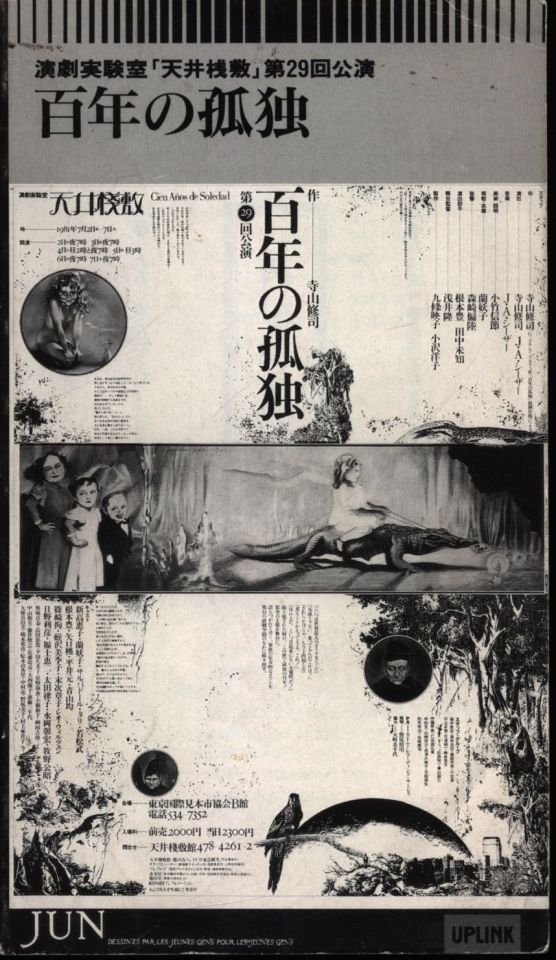#Tenjo Sajiki
Text
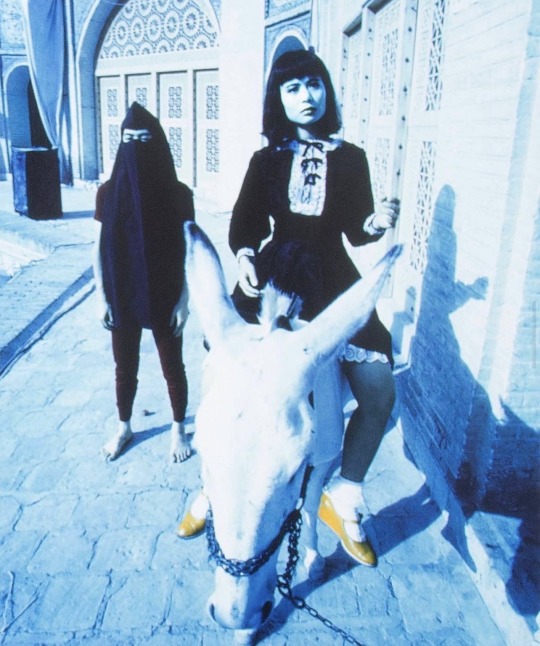
Japanese theatre troupe Tenjo Sajiki visit the Shiraz Arts Festival in Iran (1973) Ph. Shuji Terayama
239 notes
·
View notes
Text

Tenjo Sajiki Sitting On a Piece of Set Decoration from The 'Ship of Fools' play Shiraz, Persepolis Art Festival in Iran Photography By: Shuji Terayama (1976)
#behind the scenes#tenjo sajiki#ship of fools#play#persepolis#film#festival#iran#japan#photography#shuji terayama#1976#shuji terayama archive
276 notes
·
View notes
Text

Spectacular stage directions from Shuji Terayama's Heretics
10 notes
·
View notes
Text
youtube
Found an English-language documentary on the 1978 Amsterdam and London performances of Directions to Servants, including some snippets of music (J. A. Seazer was in Tenjo Sajiki at the time). CW: nudity, depiction of (staged) torture.
Note: I wouldn't trust the things Terayama says about his childhood. I remember his biographers saying that he liked to lie about it.
I'm including some quotes below that I'd like to be able to reference later.
In Amsterdam, Terayama's production was a multimedia event, in which the audience was exposed to a mixture of sounds, half-glimpsed events, and impressions. Whilst half the audience was whisked around the theater in darkened boxes, mounted on holographs, others faced a battery of TV screens in a different part of the theater. No two people experienced the same show.
Think how strange conventional theater is: It presents a complete view of the action, whereas in real life, we only ever see a part of it. My theater is more like life: We imagine the whole thing from the part we see.
The exercises make the actor's mind blank, so that he can rediscover himself. He abandons the everyday life, the world of realism, in order to express a theatrical experience. This allows him to create from his own imagination, instead of speaking somebody else's lines like a puppet.
Every day before the play begins, Terayama writes a new poem on the wall.
"The idea that this world is filled with an absent master is balanced by that of the world filled with an absent servant. When the balance is equal, then this balance becomes my soul, and I am free."
What I hope to describe in the play is the current state of the world: a society without strong leaders or politicians. But the problem is not the absence of leaders or masters but the fact that society needs masters in the first place.
5 notes
·
View notes
Text
youtube
薔薇門 (Baramon) by J.A. Caesar (1972)
#lgbt history#revolutionary girl utena#gay history#j. a. seazer#shuji terayama#terayama shuji#utena#music#gay culture#felt like sharing for posterity#baramon#tenjo sajiki#Youtube#tenjou sajiki
5 notes
·
View notes
Photo


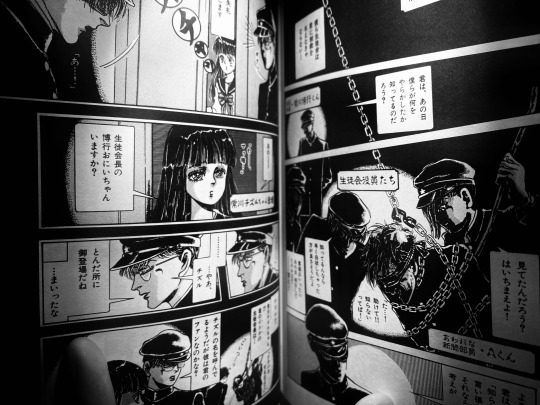



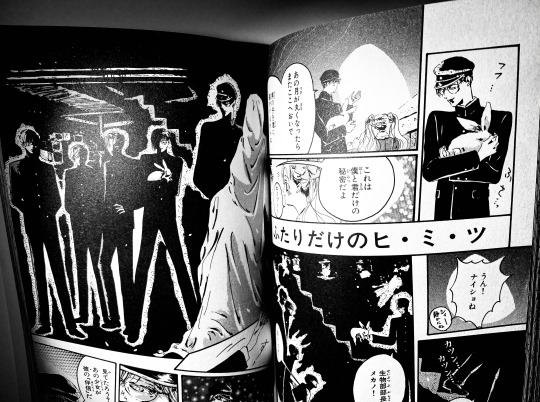

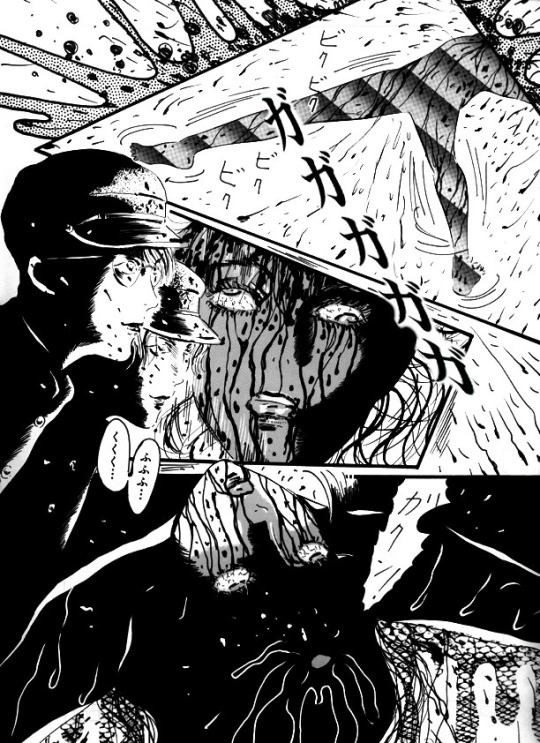

Lychee before Furuya: These images are from the short mangas Das Brute: Blood, Moon Age 15: Damnation, and Jinta ☆ Jinta by pseudonymous manga author Not Osada. Like Furuya, Osada was an audience member for the original Tokyo Grand Guignol underground performances who was left fascinated by the aesthetics and bizarre narratives of their plays. While Furuya’s manga was based more or less on the direct events of the play, in Osada’s short stories a student council reminiscent of the light club are depicted carrying out various atrocities in scenes that mirror the aesthetic fixations of the plays. The short comics in question were published in the anthologies Night Reading Room (1988) and Blind Beast (1996). Moon Age 15 would be most recognizable to fans. In the short story, the club grow concerned about their current hideout (an abandoned industrial shelter that they converted into a space called Eden) after a lonely girl discovers a lab rabbit kept by one of the members outside the space. They eventually lure her into Eden under the pretense of letting her meet her first friend, just to shock her with a grotesque robot made of garbage. They then trap her in the space and burn it to the ground, killing both the girl and the robot in the process. Moonlight lingers as a continual archetype throughout the stories, matching the Tokyo Grand Guignol’s distinctly nocturnal atmosphere. And during the climax of Das Brute: Blood, the student council’s leader (the story’s own stand-in for Zera) refers to the blood of their last victim as being “dirty”, like how the teacher in Mercuro calls Mikami’s blood dirty after killing him in the medical lab at the end of act 2.
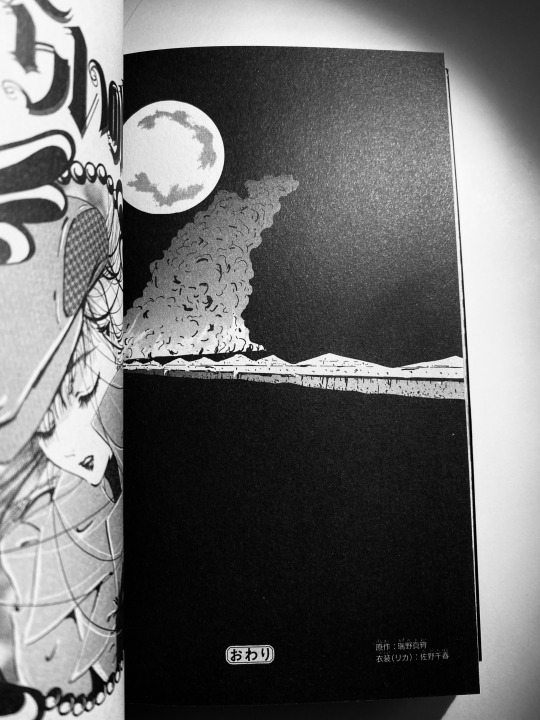
In concern of the mixed relations between later Lychee adaptions and the original Tokyo Grand Guignol affiliates, while many members held complicated feelings towards Furuya’s manga, many speak of Osada’s renditions with an open fondness. Despite Osada having retired from horror manga, he remains a fan of the Tokyo Grand Guignol. On Tsunekawa’s own accounts, Osada was even invited as a cohost for a special Tokyo Grand Guignol memorial event. While I understand the concerns of said affiliates with the increasingly detached and commercial nature of subsequent Lychee spinoffs (with there now being an idol band, comedy anime, etc) I like both Furuya and Osada’s manga works equally as their own interpretations of the TGG’s story. Neither can be direct replacements or likenesses, but instead unique adaptions of a now phantom-like work in how it was known to exist, but can never be directly witnessed in its original form. The screenplay for Lychee Light Club remains unreleased to this day, whilst the screenplays for Mercuro, Galatia Teito Monogatari and Walpurgis were all printed in one way or another in various publications. Osada and Furuya were both authors who were inspired by the underground originality of the production, but Furuya’s was the one that would gain a broader commercial success despite the underground nature of the Tokyo Grand Guignol. It could essentially be read as an ideological complication, with how the theater group was abandoned with the departure of Ameya and K Tagane, what should happen with the legacy of their art? Some fear that the success of Furuya’s manga would ultimately erase Ameya and Tagane’s history. With proper handling though, it could be a gateway into a previously obscure period of underground theater. Original video recordings do exist of several of the Tokyo Grand Guignol’s events, and if published through a public service like Ubuweb (which hosts videos of performances by the Tenjo Sajiki like Directions To Servants, Cloud Cuckooland and The Lemmings), the plays can be assured a lasting cultural legacy in the field of experimental art.
In a recent pandemic-era interview, Norimizu Ameya gave his opinions regarding the availability of video recordings of his plays. In the interview, he roughly said the following:
“I’ve always believed that there is a finite nature to theater. The fact that it disappears on the spot is the ultimate fate of theater. I have left behind hardly any works from my past. I see myself as a director rather than a playwright, so I have almost no plays. I also feel that many people generally wouldn’t enjoy the videos that do exist as records. I do think however that it’s very important that anyone who is interested in a work can watch it at any time, even if it’s a small number of people. When I was asked to direct Transfer Student, I went to the Wasada Theater Museum to watch a video of the play’s first performance under Oriza Hirata’s direction. I think it’s a good thing that the eyes that have passed through time were able to create a circuit that provides a direct connection to the past. The fact that it’s possible to transcend the finite limit to help others is a testament of humanity.“
117 notes
·
View notes
Photo

441 notes
·
View notes
Photo

Maria Austria. A scene from 'Mojin Shokan' by Tenjo Sajiki Theater, Tokyo. Mickery theater. Amsterdam, 1973
[::SemAp Twitter || SemAp::]
#BW#Black and White#Preto e Branco#Noir et Blanc#黒と白#Schwarzweiß#retro#vintage#Maria Austria#Mojin Shokan#Tenjo Sajiki#theater#Mickery theater#Amsterdam#Netherlands#1973#1970s#70s
249 notes
·
View notes
Photo

幸福が遠すぎたら/寺山修司
さよならだけが 人生ならば
また来る春は 何だろう
はるかなはるかな 地の果てに
咲いている 野の百合 何だろう
さよならだけが 人生ならば
めぐり会う日は 何だろう
やさしいやさしい 夕焼と
ふたりの愛は 何だろう
さよならだけが 人生ならば
建てた我が家 なんだろう
さみしいさみしい 平原に
ともす灯りは 何だろう
さよならだけが 人生ならば
人生なんか いりません
-----------------------------------------------------------------------------------------------------------
If Happiness Is Far Away/Shūji Terayama
If life turns into
One farewell after another
Will spring ever return again?
Far, far away
At the end of the world
Will the wild lillies blossom again?
If life turns into
One farewell after another
Will the day of our reunion ever come?
On a warm, warm
Aferglow
Will our love be again?
If life turns into
One farewell after another
Where will my home be, then?
At a lonely, lonely
Wasteland
Will light ever return?
If life turns into
One farewell after another
Then I guess
I don't need life
30 notes
·
View notes
Photo
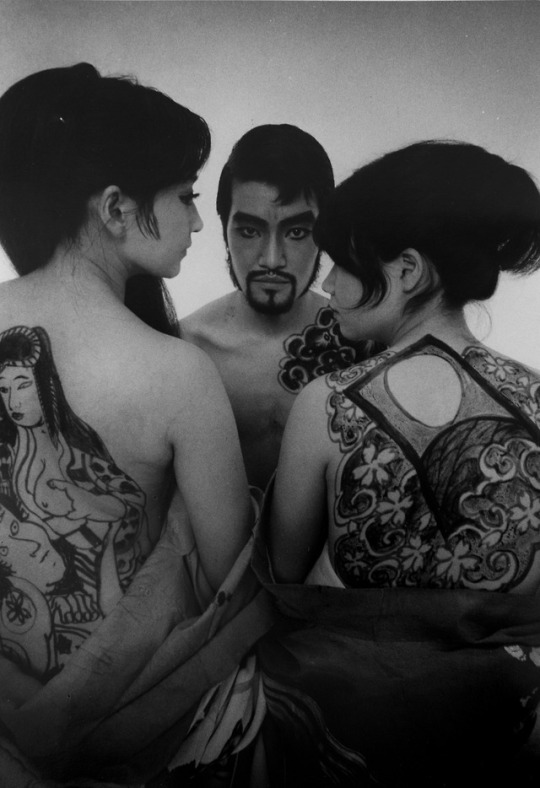
Tenjo Sajiki theater group, 1968 - Daido Moriyama
39 notes
·
View notes
Photo

Masamichi Oikawa - Crimes Comitted by Dr. Garigari (Tenjo Sajiki) [poster, silkscreen, 1969]
78 notes
·
View notes
Text
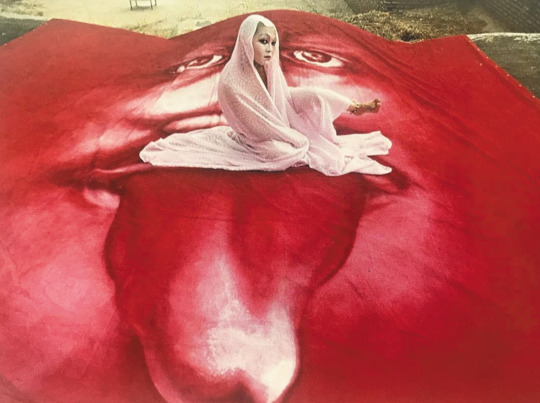
Tenjo Sajiki Sitting On a Piece of Set Decoration from The 'Ship of Fools' play Shiraz, Persepolis Art Festival in Iran Photographed By: Shuji Terayama (1976)
#behind the scenes#tenjo sajiki#ship of fools#play#persepolis#film#art#festival#iran#japan#photography#shuji terayama#1976#red
323 notes
·
View notes
Text

3 notes
·
View notes
Text
1 note
·
View note
Video
youtube
The Hanging Tree by J. A. Seazer (首吊りの木 / J. A. シーザー)
首吊りの木にサクラが咲いた
みんな忘れてしまったよ
取り残された女の事は
首吊りの木のサクラが散った
どこか引越ししてったよ
取り残された女が一人
ああ、灯せ
氷の愛はそんなもの
男が死ねば女が残り
女が死ねば男が残り
サクラが咲けば散るばかり
首吊りの木にカラスが止まる
誰も噂をしないのさ
女悲しい恋だったとて
首吊りの木は我が家の木だよ
みんな忘れてしまったよ
たった一度のおふくろの恋
Sakura have blossomed on the hanging tree
Everyone has forgotten
About the woman left behind
They’ve fallen, the sakura on the hanging tree
She has moved away
The woman left all alone
Oh, light a fire
Frozen love is like that
If he dies, she is left behind
If she dies, he is left behind
Sakura blossom only to fall
A crow lands on the hanging tree
No one speaks of it now
The woman’s sorrowful love
The hanging tree is our own
Everyone has forgotten
The one and only love of my mother
14 notes
·
View notes
